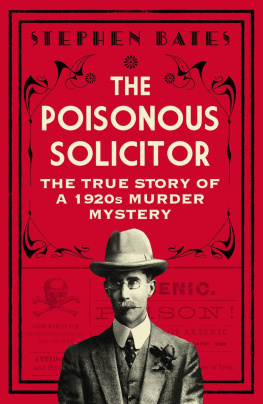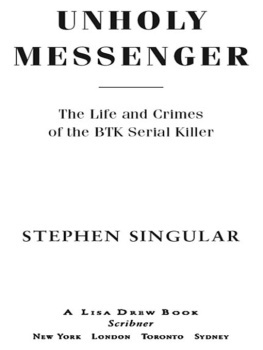
I N THE M IND OF A F EMALE S ERIAL K ILLER
IN THE MIND OF A FEMALE SERIAL KILLER
Stephen Jakobi

First published in Great Britain in 2017 by
Pen & Sword History
an imprint of
Pen & Sword Books Ltd
47 Church Street
Barnsley
South Yorkshire
S70 2AS
Copyright Stephen Jakobi, 2017
ISBN 9781526709714
eISBN 9781526709738
Mobi ISBN 9781526709721
The right of Stephen Jakobi to be identified as Author of this work has been asserted by him in accordance with the Copyright, Designs and Patents Act 1988.
A CIP catalogue record for this book is available from the British Library.
All rights reserved. No part of this book may be reproduced or transmitted in any form or by any means, electronic or mechanical including photocopying, recording or by any information storage and retrieval system, without permission from the Publisher in writing.
Pen & Sword Books Ltd incorporates the Imprints of Pen & Sword Archaeology, Atlas, Aviation, Battleground, Discovery, Family History, History, Maritime, Military, Naval, Politics, Railways, Select, Transport, True Crime, Fiction, Frontline Books, Leo Cooper, Praetorian Press, Seaforth Publishing, Wharncliffe and White Owl.
For a complete list of Pen & Sword titles please contact
PEN & SWORD BOOKS LIMITED
47 Church Street, Barnsley, South Yorkshire, S70 2AS, England
E-mail:
Website: www.pen-and-sword.co.uk
Preface
D uring six short weeks that the most successful female serial killer in modern British history was in the service of Mr Gardner, a total of three dogs, one cat, one parrot, twelve canaries and linnets, and some goldfish died very mysteriously.
She was in service of Mr Brown a fortnight, during which time the cat, a canary, a linnet and some goldfish died, and the parrot was thought to be dying. Mr Judd, a bird fancier, was called in to see it, and he was of the opinion that its neck had been pinched, it being swollen at the time.
In September 1870, she was in the service of Mr Thomas for about a month, and while there, a fowl and three canaries died mysteriously. The fowl was found behind some wood where it could not have reached without having being placed there. All the live animals at the house had died.
During the three days she was in the service of Mrs Beer, a cat and a canary both died mysteriously.
The grand total of three dogs, three cats, at least seventeen canaries and linnets, numerous goldfish, one parrot and a fowl had been killed over a two-year period, ending in April 1871 when she was brought to book. She had only been in employment for a total of four months.
In these four households, she also committed four murders of babies and toddlers (the oldest nearly 3) and two attempted murders of older children. Agnes Norman was 13 years old when she started her killing spree and 15 when it ended. She was only convicted of one attempted murder.
Introduction
O n Thursday, 13 July 1955, Ruth Ellis was executed. For me, this led to a lifelong crusade against capital punishment and my eventual career as an international criminal defence lawyer. It was not until after retirement that I could study other incidents of mistreatment of women by the reprieve system. I did not consider that notorious miscarriage of justice in the 1920s, the execution of Edith Thompson, since so much has already been written about it. The same applied to Ruth Ellis. A little-known case, battered wife Emily Swann, who was executed at the beginning of the twentieth century, had recently been studied by Dr Anette Ballinger .
These Home Office files, once opened to the public, must be the first source of information about the condemned. For over 100 years, the final decision on a reprieve was made by the Home Secretary. In the 1920s, a retired Permanent Secretary to the Home Office wrote about the procedures followed after a death sentence has been pronounced.
When any prisoner is sentenced to death, this is immediately reported to the Home Office by the Governor of the prison. The Judge also writes to the Home Secretary, forwarding a copy of his notes of the evidence and reporting any recommendation of the jury. The Judge sometimes states at once his own opinion on the case but more frequently waits before expressing his views until the prisoners appeal has been heard or the Home Office has asked for them. In most cases petitions are received from the prisoners solicitor or his friends. In any case that has excited much public attention, whatever its merits, petitions from the public pour in in large numbers. But whether there are any petitions or not, minute enquiries are made through the police and otherwise into the prisoners history and character into all circumstances which may throw light on the motive the murder and of an any uncertain features in the crime In most cases the Home Secretarys final decision is not announced until three days before the date fixed for the execution. These files contain all the relevant information about the condemned known to the authorities at the time.
This procedure, with the Home Office death files it gave rise to, commenced in the 1850s and was to be continued, virtually unchanged, until the abolition of capital punishment in the 1960s. Their contents used to be subject to 100 years burial as Official Secrets before being opened to the public, but a recent relaxation has made files over 70 years old accessible. This batch included the case of Louie Calvert, a little-known serial killer of the 1920s. Her death file would otherwise have remained locked away for another decade.
This led to my discovery of an exercise book, her remarkable 5,000-word autobiography written in the condemned cell at Strangeways, Manchester, a few days before her execution . But how true was it?
My knowledge of legal procedure had benefits. The penultimate stage in the preparation of the case for trial is where the prosecutor considers all the witness statements and documents, before telling the police to warn those whom he considers are central to the case to be available for the trial. There is a discard pile of witness statements involving inadmissible evidence, irrelevancies to the main theme of the prosecution case, and other superfluous material. The whole of the evidence, used or unused, is to be found in the prosecutors papers that were part of the death file. The only information the police really had about the early days of Calverts life are to be found in Sister Ediths statement to the police. The course of the relationship between Calvert and Mrs Waterhouse, her final victim, is to be found in the statement of the bookseller who sent her to the police. Neither of them gave evidence in public.
Calverts criminal record comprised mainly petty thefts in petty sessions. She was sent to the West Riding quarter sessions held in Leeds twice, once so that she could be sent for borstal training, and ten years later because the housebreaking offence was so serious the magistrates could not deal with it. Fortunately, the procedure involved in sending a case for trial to quarter sessions meant that the quarter sessions records include the sworn witness statements given before the magistrates. There was no trial as such, since, inevitably, Calvert pleaded guilty. Otherwise she appeared in the magistrates courts of Ossett, Dewsbury, Leeds, and once in Bradford. It was necessary to either travel to local museums, who held the archives of such minor trials as were available, or employ researchers.
I researched local records in Leeds and Wakefield with the help of Calverts great-niece, Susan Holt, who had grown up in Calverts home town of Ossett, West Yorkshire. It was Holt who supplied me with the revealing family photographs mutilated by her grandmother, Calverts sister Edith. Unfortunately, the archives are incomplete. I was forced to rely on local newspapers of the time ( Ossett Observer , Dewsbury Recorder ) for the petty sessions details. I did manage to discover, however, that in the 1920s, journalists used shorthand, and where it was possible to compare the clerks notes with the report in the local paper, the accounts were virtually identical. For information on spells in prison and date of release, the prison governors diary, known as the prison calendar, is the best source of information. With the aid of ancestry.com and Internet search engines, I discovered much of the complex truth.
Next page













